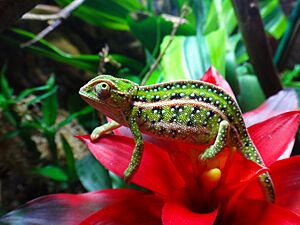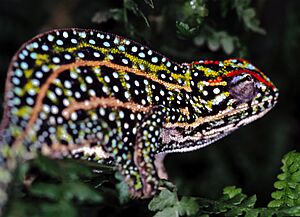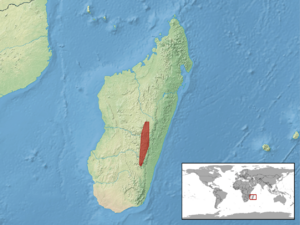Jewelled chameleon facts for kids
Quick facts for kids Jewelled chameleon |
|
|---|---|
 |
|
 |
|
| Conservation status | |
| Scientific classification | |
| Genus: |
Furcifer
|
| Species: |
campani
|
 |
|
| Synonyms | |
|
|
The jeweled chameleon (Furcifer campani) is a colorful lizard found only in Madagascar. It is also known as Campan's chameleon or the Madagascar forest chameleon. This amazing creature lives in the central highlands of Madagascar. Sadly, its home is at risk from bush fires and losing its natural habitat.
Contents
About the Jeweled Chameleon's Name
The scientific name for this chameleon is campani. It was named after Dominique Campan. He was a French person who lived in Madagascar.
What Does the Jeweled Chameleon Look Like?
The jeweled chameleon can grow to be about 14 centimeters (5.5 inches) long. This measurement includes its tail. Its body can be light green, dark green, or even brown.
It has three light brown stripes running along each side of its body. You can also see many small, bright spots between these stripes. Its head often has tiny red spots, making it look like a jewel. This chameleon also has a small bumpy ridge along its back.
Where Do Jeweled Chameleons Live?
The jeweled chameleon lives only in the central mountains of Madagascar. It prefers high places, from 1,850 to 2,300 meters (6,070 to 7,550 feet) above sea level.
Its home stretches from an old volcano called Ankaratra to the Andringitra National Park. This area is about 14,500 square kilometers (5,600 square miles). However, only parts of this land are suitable for them. They live on the ground in mountain grasslands and heathlands. These areas have shrubs and a few scattered trees.
How Jeweled Chameleons Hunt and Eat
Chameleons are ambush predators. This means they wait quietly for their food to come close. They stand very still until they spot a tasty insect.
Then, they shoot out their long tongue very fast. The tip of their tongue is sticky, which helps them catch the insect. Their diet is mostly made up of different kinds of insects.
Life Cycle and Reproduction
Jeweled chameleons reproduce two or three times each year. The female chameleon lays about eight to twelve eggs. She hides these eggs in secret spots to keep them safe.
When studied in a lab, the eggs take about nine months to hatch. This happens at a temperature of 20 degrees Celsius (68 degrees Fahrenheit). The baby chameleons are very tiny when they hatch, only about 23 millimeters (0.9 inches) long. They grow quickly and can have their own babies when they are just three months old. Some people say these chameleons might hibernate during winter. They might bury themselves in leaves to stay warm.
Why the Jeweled Chameleon Needs Our Help
The jeweled chameleon is listed as "Vulnerable" on the IUCN Red List of Threatened Species. This means it is at risk of becoming endangered. While they are common in some areas, their numbers are not fully known.
Their homes are being cleared for farms. Also, there is a yearly cycle of burning the land. This burning destroys their habitat. Another chameleon, the white-lined chameleon (F. lateralis), lives in the same areas. That species seems to handle these changes better.
The national park should offer some protection. However, the chameleons on the Ankaratra mountains are still in danger. In 1994, over five thousand jeweled chameleons were taken from Madagascar. Since then, it has been illegal to export most chameleons from the island. But some might still be illegally collected. Experts believe we need to stop the damage caused by fires in the grasslands where these chameleons live.


